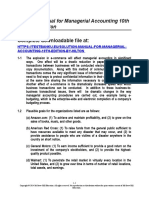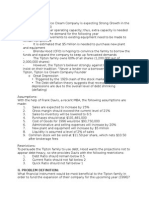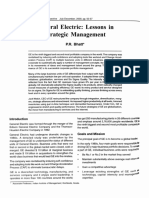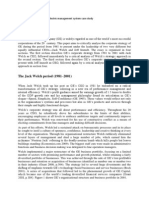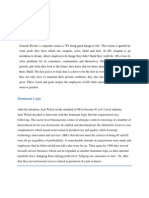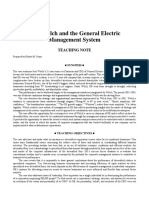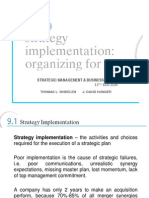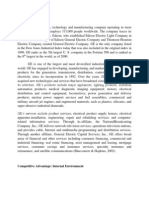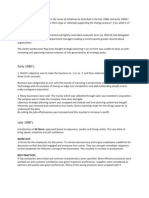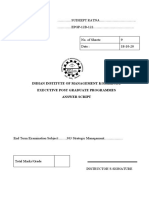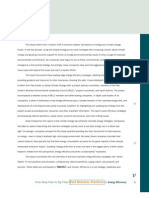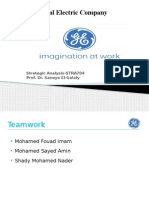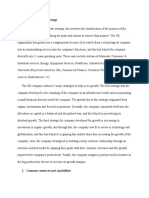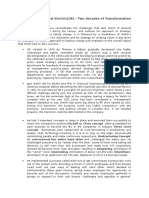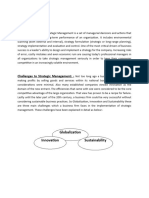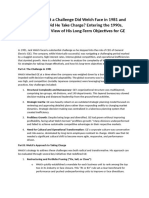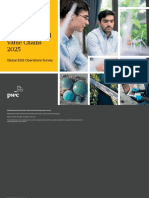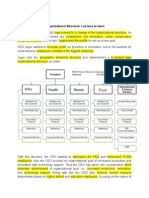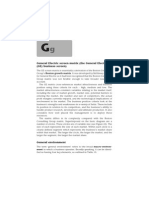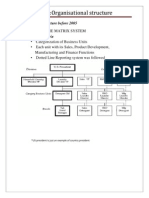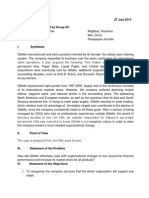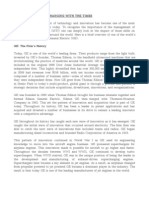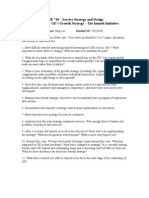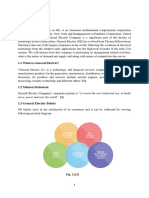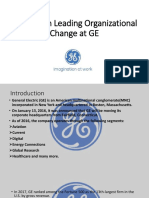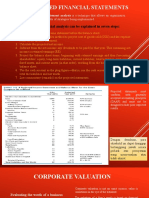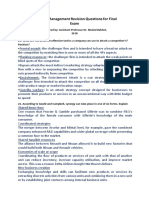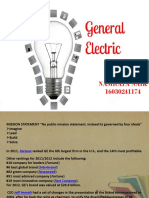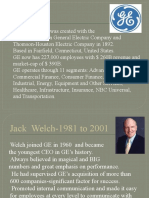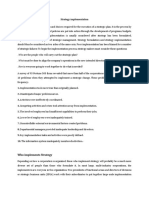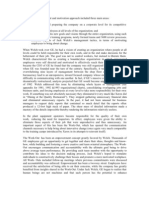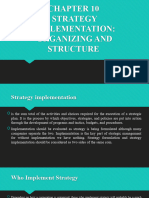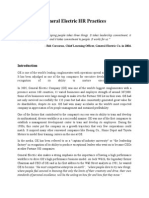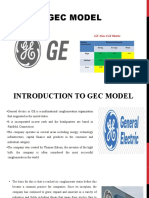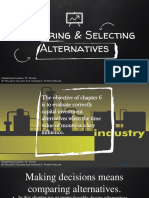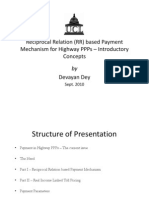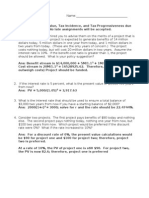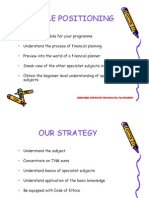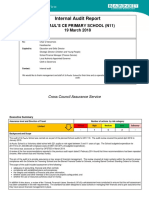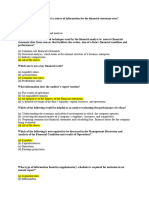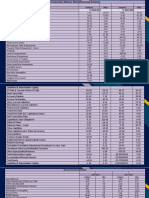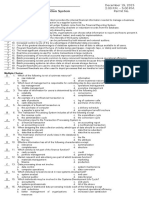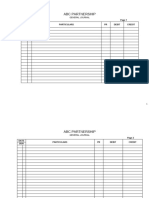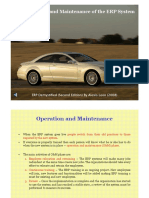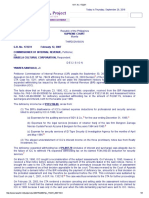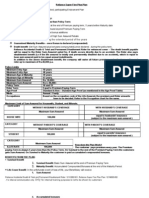Ges Global M Form Business Structure
Ges Global M Form Business Structure
Uploaded by
Abir Nafis ShaheedCopyright:
Available Formats
Ges Global M Form Business Structure
Ges Global M Form Business Structure
Uploaded by
Abir Nafis ShaheedOriginal Title
Copyright
Available Formats
Share this document
Did you find this document useful?
Is this content inappropriate?
Copyright:
Available Formats
Ges Global M Form Business Structure
Ges Global M Form Business Structure
Uploaded by
Abir Nafis ShaheedCopyright:
Available Formats
Group-3
GEs Global M Form business structure:
Under Jack Welch, GEs global business structure was basically the Global M-Form structure. The headquarter included the CEO, Jack Welch, along with 3 more members. The headquarter was known as the corporate executive office. Under this, there were the corporate staffs divided in 8 divisions. Each international office was responsible for its own plans of working and under them operated all the businesses of GE in that country. The international offices reported to the corporate executive office
GEs Hierarchy of growth:
GEs gradual growth from a single focus business to a diversified multi-business corporation can be summarized in the following steps: Generation, distribution and use of electric power Organic growth and transformation to a SBU-based system Divesting unprofitable and low profit generating businesses, acquiring new profitable businesses. These businesses were very much diversified. Included both manufacturing and service related businesses which were not at all related to its core business. Expanded internationally. Went for joint-ventures and acquisitions. Acquisition mainly took place in countries which were then facing economic downturns. GE wanted to capitalize on this opportunity of buying the business incurring lower cost than normal. GE increased its focus more on service, specifically product service. Going for e-business.
Rumelts Diversification Typology:
GE is a Diversified unrelated corporation as its SBUs are not related in strategically significant way. Its core business includes lighting, appliance, motor, transportation, turbine, and equipment, which generates less than 70% of the total revenue. Whereas technology business included industrial electronics, medical systems, aircraft engines etc. and service business 1
Group-3 integrated nuclear service, construction and engineering etc which generated almost 75% of revenues as of 2000. The Diversified unrelated Portfolio:
GE 1982
TECHNOLOGY
Industrial electronics Medical systems Aircraft engines
CORE
Lighting, appliance, motor, transportation, turbine, and equipment
SERVICES
Nuclear service, construction and engineering, GECC info
Porter on synergy:
Transfer of skills: Welch always emphasized on the transfer of skills among different departments as well as different businesses of GE. The Multi-dimensional structure is especially helpful for this. He also focused on the huge task of realigning the skill setsto develop and share the skills of individual employees. To strengthen GEs individual business, Welch articulated GE as a boundaryless company; characterized by an open, anti-parochial environment, friendly toward the seeking and sharing of new ideas, regardless of their origins. Sharing of activities: GE focuses on developing effective process than controlling individual activities. They treated their suppliers as partners. Welch always emphasized on the sharing of knowledge and activities within departments and different SBUs. The Crotonville management development facility helped teams of managers to work together on real priority issues and share the results of the discussion to benefit GEs different SBUs. Thats how by transfer of skills and sharing of activities GE created great synergy among its SBUs.
Group-3
Core competence:
Organizational culture High performing employees Financial resources Strong Brand image Valuable Appropriable in multiple industries Inimitable
Dominant Logic for GE:
Dominant logic refers to how things are done in an industry or a firm. It can be determined by the industry or firm history, market trends, technologies, regulations, production processes, etc. Generally, dominant logic concept is more appropriate for an industry. But in this case, both in the era of Reg Jones and Jack Welch, GE has demonstrated their very own style of performing and getting things done. In fact, there were two dominant logics prevailing all over GE under these two CEOs. Dominant logic before Reg Jones: In 1930s GE used to follow highly centralized and tightly controlled form of corporate operation. Though in 1950 it went for decentralized approach, the overall operating process was bureaucratic. Dominant logic under Reg Jones: In the Reg Jones reign, GE transformed from department system to groups-divisions-departments-SBU system. The SBU based structure and strategic planning process was central to its management process. Apart from this structural change, GEs focus was still profit-oriented and they used to perceive a business well-performed if it was making enough profit. Dominant logic under Jack Welch: Jack Welch took this profit-seeking focus of GE to the next step. He used to believe in and wanted to achieve better than the best position in the market. His logic was to change the cognitive schema of everybody in GE to think in a more competitive way and push the best out of everybody. He cut the hierarchical steps down and downsized unnecessary employees. It was more like Do or die challenge for everybody. Continuous innovation, development and opportunists behavior was the prevailing dominant logic. We have learned from this that one thing that never changed in GE is that they were always ready to accept a change whenever it is necessary. They didnt wait for the industry to show the way; rather they created their own way and benchmark for others. 3
Group-3
Corporate synergy & business synergy
1. Corporate Synergies Improving product or process technologies: Each SBU identified the flaws in product or process technologies through Six Sigma plan and it was shared across GE. Apart form this programme; GE SBUs disseminated any successful practice and process and the whole company adopted that procedure. For example, the diagnostic sensors and communication capabilities, implanted in GE medical devices were gradually espoused by all other SBUs. This enable GE to provide more value added services to its customers. Replacing inexperienced managers Type 4managers were singled out and were removed because they carried values which contradicted with the overall culture of GE. The 350 business units were the source of ideas that are to be shared, learned, and spread and anyone who failed to do was actually hindering the overall growth of GE. Thus managers ranked their subordinates on a 1 to 5 scale evaluating their long term performance and the people rated 5 were removed. Restructuring the business: Jack Welch delayered the organizational structure by eliminating the sector level. The idea of massive downsizing and restructuring lead to a more agile and lean GE with a significant increase in operating profits ($1.6 billion to $2.4 billion). Businesses were categorized as core, high technology, and services with standard for each business should be #1 or #2 otherwise close resulted in discharging of 200 SBUs and acquisition of 370 businesses. This step made GE a highly diversified company with quality leadership in each of its businesses. The implementation of real time planning in stead of conventional strategic planning system and a budgeting process aligned with external criteria made GE more competitive.
Group-3 GE entered product service because they forecasted the growth opportunity in this arena and in the year 2000 75% of GEs business is comprised of service business. The service business is focused on each businesses and aim to make each of them more productive. Correcting strategic errors Six Sigma design applied across all the SBUs improved quality, lowered costs, and increased productivity of the whole company. A revenue of $750 million over the investment and an anticipated additional revenue of $1.5 billion resulted from sharing the best practices and achievements of single businesses. Facilitating skill and resource linkages across SBUs GE leveraged their skills and resources across SBUs to gain synergy. By instilling the notion of boundaryless company, GE eliminated all the barriers among different SBUs and applied the best practice of one unit into another. As a result it was easier to share know-how, process, resources, and techniques throughout the company. Canadian GE shared their flexible job shop techniques with U.S. appliance business helped to reduce production cycle and inventory cost. The Quick Response Programme which emerged due exchange of information between Canadian GE and U.S. appliance plant became a source of synergy as other businesses adopted this programme. Providing expertise, e.g. global expansion, acquisition Paolo Fresco was one of the key resources to enhance global expansion as he helped to increase the overall portfolio of GE by engaging in acquiring and partnering with multiple diversified business units. GE utilized its knowledge of the situation during economic uncertainty and ended up with global operations in Europe, Asia, and Mexico. GEs global revenues excelled domestic sales and made GE a globally competitive company. 2. Business-Unit Synergies
Group-3
Compatibility Same organizational culture and similar values e.g. open, participative, team building, quality focus were disseminated among all the SBUs which contributed to the success of each unit. All the SBUs applied six sigma plan and the units adopted the practices that were successful for other.
Complementarity Since GE has a diversified portfolio of business units the synergies arise from differences. For example, the Diagnostic sensors and Communication capabilities were installed by medical imaging business and later it was adopted by businesses as diversified GE engines and GE power system.
Parenting strategy:
The parenting strategy for GE is a combination of Development and Linkage strategy. Because the degree of corporate intervention is high and the corporate intervention is done on operating as well as financial activities. Using the notion of stretch, Welch actively cultivates synergies among SBUs and does the deal making, restructuring and buy and sell of businesses.
Strategy: Who is going to replace Jack Welch?
There are four men in Jack Welchs corporate executive office; three Vice Chairmen Paolo Fresco, Edward E. Hood, Jr., John F. Burlingma and an Executive Vice Chairman Frank P. Doyle. Any of three Vice Chairmen can succeed Jack Welch upon his retirement. These people have been working with Jack for a very long time and have in depth knowledge about GE, its culture, employees, and tactics which work successfully. Frank P. Doyle can be promoted to Vice Chairman and others can be replaced from Senior Vice President Position based on Jacks 4E criteria.
You might also like
- Extra Book - June 2015 FinalDocument84 pagesExtra Book - June 2015 Finaldanishzafar100% (1)
- General Electrics Ecomagination Strategy Case StudyDocument4 pagesGeneral Electrics Ecomagination Strategy Case StudyBlairEmrallaf100% (5)
- Solution Manual For Managerial Accounting 10th Edition by HiltonDocument19 pagesSolution Manual For Managerial Accounting 10th Edition by Hiltona46078460250% (4)
- Case Study Jack Welch and GE TransformationDocument6 pagesCase Study Jack Welch and GE TransformationReyte on Publishing A. Johnson80% (5)
- GEs Growth StrategyDocument15 pagesGEs Growth Strategyaryanrajvk100% (5)
- International Divider WallsDocument20 pagesInternational Divider Wallshaliza amirah100% (2)
- I. Case ContextDocument3 pagesI. Case Contextcesarvirata13% (8)
- Cash and Cash Equi Theories and ProblemsDocument29 pagesCash and Cash Equi Theories and ProblemsIris Mnemosyne100% (5)
- General Electric: Lessons in Strategic Management: P.R. BhattDocument8 pagesGeneral Electric: Lessons in Strategic Management: P.R. BhattLM_SNo ratings yet
- General Elecrtic: Corporate Strategy ofDocument4 pagesGeneral Elecrtic: Corporate Strategy ofdanializ60% (5)
- Jack Welch Case StudyDocument6 pagesJack Welch Case StudySunil Patil100% (1)
- General ElectronicsDocument6 pagesGeneral ElectronicsimtiazrashedNo ratings yet
- GE - Jack Weclch - GROUP GEDocument6 pagesGE - Jack Weclch - GROUP GEsatyam mishraNo ratings yet
- Jack Welch and The General Electric Management System: Case SeventeenDocument5 pagesJack Welch and The General Electric Management System: Case SeventeenBarunaNo ratings yet
- The Strategic Development of Procter and Gamble Into A GlobalDocument5 pagesThe Strategic Development of Procter and Gamble Into A Globalkhurram36No ratings yet
- 9+ +Strategy+Implementation+ +Organizing+for+ActionDocument59 pages9+ +Strategy+Implementation+ +Organizing+for+Actiongary_ngg100% (1)
- General ElectricDocument8 pagesGeneral ElectricAnjali Daisy100% (1)
- What Is WelchDocument2 pagesWhat Is WelchGunjan Vishal Tyagi100% (1)
- Globalization Case Analysis: GE's Two Decade Transformation (Jack Welch) - IIMK SolutionDocument10 pagesGlobalization Case Analysis: GE's Two Decade Transformation (Jack Welch) - IIMK SolutionSudeept RatnaNo ratings yet
- Lean in Six StepsDocument5 pagesLean in Six StepsMohamed Farag Mostafa100% (1)
- PEW Energy Efficiency ExSummaryDocument3 pagesPEW Energy Efficiency ExSummaryfdrz200887No ratings yet
- General Electric Management AnalysisDocument20 pagesGeneral Electric Management Analysisshadynader100% (1)
- General Electric Company - EditedDocument4 pagesGeneral Electric Company - EditedCecil HenryNo ratings yet
- GE - 2decades of Transformation - Rollno 21Document3 pagesGE - 2decades of Transformation - Rollno 21aruntce_kumar9286No ratings yet
- Strategic Manager - AssignmentDocument7 pagesStrategic Manager - AssignmentVishal SinghNo ratings yet
- Last YearDocument17 pagesLast Yearsahil jainNo ratings yet
- PWC Global Esg in Operations SurveyDocument36 pagesPWC Global Esg in Operations SurveyMax Martin100% (3)
- P&G and Unilever Case Study-Discussions in Lecture-15Document5 pagesP&G and Unilever Case Study-Discussions in Lecture-15Sambit Mishra50% (2)
- Group 3 - PROCTOR AND GAMBLE ORGANIZATION 2005Document19 pagesGroup 3 - PROCTOR AND GAMBLE ORGANIZATION 2005RehanshuVij100% (2)
- Strategic Management General Electric MatrixDocument15 pagesStrategic Management General Electric MatrixbogdanbucureanNo ratings yet
- P & G:Organisational StructureDocument7 pagesP & G:Organisational StructureZas AroraNo ratings yet
- Manpri Case07 GilletteDocument7 pagesManpri Case07 GilletteFrancisco MarvinNo ratings yet
- Strategy Implementation and ControlDocument43 pagesStrategy Implementation and ControlDr Rushen SinghNo ratings yet
- Case Study #7: Gillette 27 July 2013 Case Analysis Prepared by Group #5Document7 pagesCase Study #7: Gillette 27 July 2013 Case Analysis Prepared by Group #5Liz EspinosaNo ratings yet
- Jack Welch & Ge WayDocument27 pagesJack Welch & Ge WayManvendra ShahiNo ratings yet
- General ElectricDocument3 pagesGeneral ElectricLeidy Johanna Cardenas SolanoNo ratings yet
- Casestudy1 AssignmentDocument5 pagesCasestudy1 AssignmentPing Lei LeiNo ratings yet
- Deloitte-Ch-En-Strategic-Cost - TransformationDocument9 pagesDeloitte-Ch-En-Strategic-Cost - TransformationrerodgersNo ratings yet
- Project ReportDocument7 pagesProject ReportShahrooz JuttNo ratings yet
- Bucifal Case Study-General Electric - MORE Nov2009 - FinalDocument12 pagesBucifal Case Study-General Electric - MORE Nov2009 - FinalLixin Teh100% (3)
- Jack Welch Leading Organizational Change at GEDocument18 pagesJack Welch Leading Organizational Change at GEShivNo ratings yet
- General ElectricDocument12 pagesGeneral ElectricRasha ElbannaNo ratings yet
- Projected Financial StatementsDocument16 pagesProjected Financial StatementsRambu MahembaNo ratings yet
- 3M ReportDocument6 pages3M ReportlonewolfNo ratings yet
- Revision Questions For Final Exam p2Document8 pagesRevision Questions For Final Exam p2EngMohamedReyadHelesyNo ratings yet
- 1 Jackwelch and General ElectricDocument6 pages1 Jackwelch and General ElectricrahulkejNo ratings yet
- Operational ExcellenceDocument16 pagesOperational ExcellenceRakesh VanamaliNo ratings yet
- GEDocument23 pagesGENamrataNaikNo ratings yet
- First AssignmentDocument5 pagesFirst Assignmentমুহম্মদ কামরুল ইসলামNo ratings yet
- About GEDocument12 pagesAbout GESurupa HajraNo ratings yet
- Tugas Pak DedyDocument4 pagesTugas Pak DedyAhmad JamalludinNo ratings yet
- Case Study Jack WelchDocument5 pagesCase Study Jack WelchVerma1311No ratings yet
- General Electric Power Business Unit: Strategic Analysis Tools and Techniques - Coursework 2Document13 pagesGeneral Electric Power Business Unit: Strategic Analysis Tools and Techniques - Coursework 2Ibilola IbisankaleNo ratings yet
- Chapter 10 Strategy Implementation Organizing and StructureDocument28 pagesChapter 10 Strategy Implementation Organizing and Structurejecille magalong100% (1)
- Marketing Management: The G Way On E-BusinessDocument17 pagesMarketing Management: The G Way On E-BusinessRaja GuptaNo ratings yet
- Basic Model of SMDocument13 pagesBasic Model of SMRohit GoelNo ratings yet
- IBM Global Making Change Work StudyDocument48 pagesIBM Global Making Change Work StudyOscar GessangNo ratings yet
- Curriculum Notes - Session 1 - The Woulds of Wall StreetDocument21 pagesCurriculum Notes - Session 1 - The Woulds of Wall Streetakshitamukherjee11No ratings yet
- GE HR PracticesDocument7 pagesGE HR PracticesDevika Johar100% (1)
- 5-Gec ModelDocument10 pages5-Gec Modelsirisha INo ratings yet
- Global Expansion Feasibility Framework for Scale-Ups: A proven framework for identifying the most promising countries for international expansionFrom EverandGlobal Expansion Feasibility Framework for Scale-Ups: A proven framework for identifying the most promising countries for international expansionNo ratings yet
- IT GOVERNANCE APPROACHES FOR AGILE SOFTWARE DEVELOPMENT INVESTMENTSFrom EverandIT GOVERNANCE APPROACHES FOR AGILE SOFTWARE DEVELOPMENT INVESTMENTSRating: 4 out of 5 stars4/5 (1)
- How to Enhance Productivity Under Cost Control, Quality Control as Well as Time, in a Private or Public OrganizationFrom EverandHow to Enhance Productivity Under Cost Control, Quality Control as Well as Time, in a Private or Public OrganizationNo ratings yet
- A Study of the Supply Chain and Financial Parameters of a Small BusinessFrom EverandA Study of the Supply Chain and Financial Parameters of a Small BusinessNo ratings yet
- Statement of Comprehensive Income - ValixDocument7 pagesStatement of Comprehensive Income - ValixYstefani ValderamaNo ratings yet
- Comparison of AlternativesDocument26 pagesComparison of AlternativesMarielle CambaNo ratings yet
- RJ 20-21Document1 pageRJ 20-21sunil jadhavNo ratings yet
- Reciprocal Relation (RR) Based Payment Mechanism For Highway Ppps - Introductory Concepts Concepts by Devayan DeyDocument18 pagesReciprocal Relation (RR) Based Payment Mechanism For Highway Ppps - Introductory Concepts Concepts by Devayan DeyAjay PannuNo ratings yet
- Form No 16 (By Sagar Goyal)Document3 pagesForm No 16 (By Sagar Goyal)sagarNo ratings yet
- Rooms Available in Kota2Document7 pagesRooms Available in Kota2Satyanneshi ERNo ratings yet
- 432HW5 KeyDocument6 pages432HW5 KeyJs ParkNo ratings yet
- Dabur India LimitedDocument24 pagesDabur India Limitedshine_star4100% (2)
- Bank P.O. Mock Test: Special SupplementDocument18 pagesBank P.O. Mock Test: Special SupplementAshok ANo ratings yet
- Solutions ManualDocument226 pagesSolutions Manualuzumakideva26No ratings yet
- CFP - Module 1 - IIFP - StudentsDocument269 pagesCFP - Module 1 - IIFP - StudentsmodisahebNo ratings yet
- Internal Audit Report - ST Pauls CE Primary School N11Document15 pagesInternal Audit Report - ST Pauls CE Primary School N11arroshan100% (4)
- თევზიანი - CHPT 5Document19 pagesთევზიანი - CHPT 5lika77678No ratings yet
- Quiz 1 SolutionsDocument10 pagesQuiz 1 SolutionsHaSelNo ratings yet
- Warren Buffett CalculationsDocument24 pagesWarren Buffett Calculationseric_stNo ratings yet
- Financial Statements For Decision Making: Powerpoint Presentation by Phil Johnson ©2015 John Wiley & Sons Australia LTDDocument30 pagesFinancial Statements For Decision Making: Powerpoint Presentation by Phil Johnson ©2015 John Wiley & Sons Australia LTDShiTheng Love UNo ratings yet
- Unilever P&G Unilever P&G Assets: Add A Footer 1Document4 pagesUnilever P&G Unilever P&G Assets: Add A Footer 1Kathreen Aya ExcondeNo ratings yet
- 3AB3S10Document8 pages3AB3S10Jason TangNo ratings yet
- AIS Prelim Exam AnswerDocument2 pagesAIS Prelim Exam AnswerWen Capuno50% (2)
- 1.4 Partnership Template Answer SheetDocument14 pages1.4 Partnership Template Answer SheetCherry May PajutiningNo ratings yet
- Operation and Maintenance of The ERP System: ERP Demystified (Second Edition) by Alexis Leon (2008)Document66 pagesOperation and Maintenance of The ERP System: ERP Demystified (Second Edition) by Alexis Leon (2008)aninandhuNo ratings yet
- CIR V IsabelaDocument6 pagesCIR V IsabelaAgnes PajilanNo ratings yet
- Financial Accounting and Statement Analysis HEC MBA Program Frequently Asked Questions and Additional InformationDocument17 pagesFinancial Accounting and Statement Analysis HEC MBA Program Frequently Asked Questions and Additional InformationBasanta K SahuNo ratings yet
- Super Five Plus Final One PagerDocument6 pagesSuper Five Plus Final One PagerAditya Singh0% (1)
- The Uniform Chart of AccountsDocument137 pagesThe Uniform Chart of AccountsDock N DenNo ratings yet


